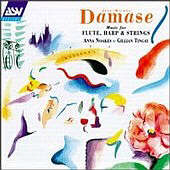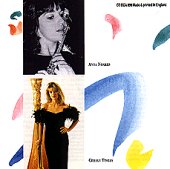Coming Soon
Radio DAMASE

          | |
"Delectably
cultivated chamber music...the ensemble play beautifully" (Gramophone)
Gramophone Critics' Choice
Penguin Guide ***
Gramophone Good CD Guide Recommendation
Click here
to visit the ASV site for more information.
|
 Critic's Choice
Critic's Choice
|
 from
Gramophone, October 1994 from
Gramophone, October 1994
I confess I had never heard of
Jean-Michel Damase until this disc arrived for review, and he is a real
find. He was born in the same year as myself (1928) and I am happy to
find a real personal affinity with his music, eclectic though it
certainly is. He was a highly precocious youngster. Colette wrote poems
for him to set to music when he was only ten and the talented young
musician studied piano under Cortot and composition under the Henri
Busser, who made the arrangement of Adam's Giselle. But as a
composer in the 1940s he was left behind by the avant-garde, for his
writing has little in common with Messiaen and Boulez and much with
Ravel. Indeed the Quintet for flute, harp, violin, viola and cello might
almost be an undiscovered piece by that master and if you like Ravel's Introduction
and Allegro you will surely find the intimacy of its writing
appealingly atmospheric. The melancholy slow movement is quite haunting
and in the chirruping finale the composer finds his own individuality.
The intimacy of the opening melody of the Sonata for flute and harp is
quite ravishing and its Andante has a melancholy charm somewhere
between Satie and Poulenc, but it is again in the Scherzo and
finale that the composer's own personality asserts itself most strongly. |
 The
Variations on "Early one morning" are introduced on the
harp; they are complex and rhapsodic, even kaleidoscopic, and again
reveal an individual voice, with the closing romp particularly
appealing, leading to a very effective reprise of the famous melody. The
Trio, which comes last on the disc but was the first work to be written
(in 1946), assimilates influences from Roussel, Poulenc and Ibert, but
again it is the whiff of Ravel that makes the idiom so haunting. The
first movement is restless without being neurotic, the Andante a
lovely muted threnody that is played with great delicacy of feeling here
and the finale is typically light-hearted. The
Variations on "Early one morning" are introduced on the
harp; they are complex and rhapsodic, even kaleidoscopic, and again
reveal an individual voice, with the closing romp particularly
appealing, leading to a very effective reprise of the famous melody. The
Trio, which comes last on the disc but was the first work to be written
(in 1946), assimilates influences from Roussel, Poulenc and Ibert, but
again it is the whiff of Ravel that makes the idiom so haunting. The
first movement is restless without being neurotic, the Andante a
lovely muted threnody that is played with great delicacy of feeling here
and the finale is typically light-hearted.
|
 |
The
performances are wholly sympathetic and refreshing (Anna Noakes is a
superb flautist) with the ensemble playing most sensitive and
integrated. The recording, too, is beautifully balanced in a warm
acoustic which casts a resonant glow over the players without masking
transparency of detail. This will almost certainly be in my next
Critics' Choice.
IM
© 1994 Gramophone Magazine |
|










